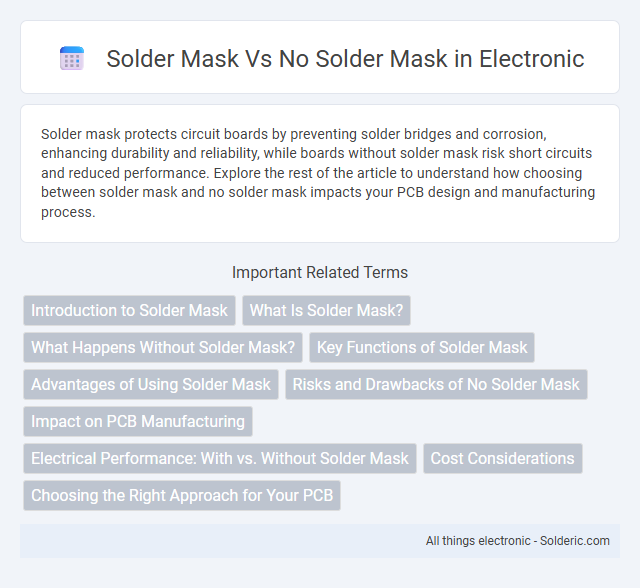Solder mask protects circuit boards by preventing solder bridges and corrosion, enhancing durability and reliability, while boards without solder mask risk short circuits and reduced performance. Explore the rest of the article to understand how choosing between solder mask and no solder mask impacts your PCB design and manufacturing process.
Comparison Table
| Feature | Solder Mask | No Solder Mask |
|---|---|---|
| Definition | Protective layer applied on PCB to prevent solder bridging | PCB surface exposed without protective coating |
| Function | Prevents solder shorts, protects traces from oxidation | Higher risk of solder bridging and oxidation |
| Manufacturing Cost | Higher due to additional masking process | Lower cost, simpler process |
| Assembly Quality | Improved with precise soldering and reduced errors | Reduced precision, increased chances of defects |
| Durability | Enhanced protection against environmental damage | Exposed copper prone to corrosion and wear |
| Visual Inspection | Clear indicator of solder areas, easier inspection | Less distinct soldering zones, harder inspection |
| Use Cases | Standard in most PCBs, essential for SMT and complex boards | Used in simple or prototype boards where cost is critical |
Introduction to Solder Mask
Solder mask is a protective layer applied to printed circuit boards (PCBs) that prevents oxidation and short circuits by insulating copper traces. Without a solder mask, PCBs are more susceptible to solder bridges, corrosion, and physical damage during assembly and operation. The presence of solder mask enhances PCB reliability, electrical performance, and manufacturing yield by ensuring precise soldering and reducing the risk of electrical failures.
What Is Solder Mask?
Solder mask is a protective layer applied to PCB surfaces to prevent solder bridges between closely spaced components and to protect copper traces from oxidation and contamination. Without solder mask, exposed copper pads are vulnerable to corrosion and unintended solder connections, which can cause short circuits and reduce the reliability of your electronic assemblies. Solder mask enhances the overall durability and performance of printed circuit boards by providing insulation and improving soldering precision.
What Happens Without Solder Mask?
Without solder mask, printed circuit boards (PCBs) experience increased risk of solder bridging between closely spaced pads, leading to short circuits and unreliable electrical connections. Exposure to environmental contaminants and oxidation on copper traces reduces the PCB's durability and performance over time. The absence of solder mask also complicates automated soldering processes, resulting in higher defect rates and production costs.
Key Functions of Solder Mask
Solder masks provide critical functions including preventing solder bridges between closely spaced components, protecting the copper traces from oxidation and environmental damage, and enhancing the overall reliability of printed circuit boards (PCBs). Without solder masks, PCBs are more susceptible to short circuits, corrosion, and contamination, which can lead to device failure. The use of solder masks also improves the precision of soldering processes in automated assembly lines.
Advantages of Using Solder Mask
Using solder mask on printed circuit boards (PCBs) prevents solder bridges and short circuits by insulating copper traces, enhancing electrical reliability. It improves the PCB's durability by protecting against corrosion, moisture, and physical damage, extending the board's lifespan. Solder mask also aids in precise soldering during manufacturing by defining solderable areas, reducing defects and rework costs.
Risks and Drawbacks of No Solder Mask
No solder mask on printed circuit boards (PCBs) exposes copper traces to oxidation, leading to increased corrosion and reduced electrical conductivity. The absence of solder mask increases the risk of short circuits due to solder bridging during assembly, compromising circuit reliability. Furthermore, PCBs without solder mask are more prone to contamination, which can cause signal interference and degradation over time.
Impact on PCB Manufacturing
Using a solder mask during PCB manufacturing significantly reduces the risk of solder bridges and short circuits by providing a protective insulating layer over the copper traces. PCBs without solder masks are more prone to oxidation, which can degrade electrical performance and increase manufacturing defects. The presence of a solder mask also enhances automated assembly processes by clearly defining solderable areas, improving yield and reliability.
Electrical Performance: With vs. Without Solder Mask
A solder mask enhances electrical performance by preventing short circuits and minimizing signal interference due to its insulating properties. Without a solder mask, exposed copper traces are more susceptible to oxidation and accidental bridging during assembly, leading to potential electrical failures. Your PCB benefits from improved reliability and reduced risk of conductivity issues when a solder mask is applied.
Cost Considerations
Choosing a solder mask significantly impacts PCB manufacturing costs by reducing the risk of solder bridging and rework expenses, ultimately lowering production defects. PCBs without solder masks often require more labor-intensive inspection and cleaning processes, increasing overall manufacturing time and costs. Investing in solder mask application streamlines assembly efficiency and minimizes waste, providing a cost-effective solution for high-volume production.
Choosing the Right Approach for Your PCB
Choosing the right solder mask approach for your PCB significantly impacts its durability and performance. Solder masks protect the copper traces from oxidation and prevent solder bridges during assembly, ensuring reliability in high-density circuits. Your decision should consider factors like manufacturing costs, environmental exposure, and the required precision in soldering to achieve optimal functionality.
solder mask vs no solder mask Infographic

 solderic.com
solderic.com